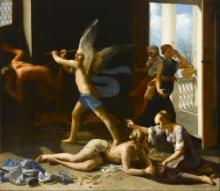
Guido Cagnacci (1601–1663) is among the most eccentric painters who worked in seventeenth-century Italy. His works, mostly religious in subject, are known for their unashamed, often unsettling, eroticism. Even though his pictorial style was influenced by some of the greatest Italian baroque painters—the Carracci, Guercino, and Guido Reni—his figurative language always remained individual and highly recognizable. The unconventionality of his work led to his being almost entirely forgotten during the eighteenth and nineteenth centuries. After exhibitions in Rimini and Bologna in 1952 and 1959, respectively, Cagnacci was rediscovered by Italian art historians and writers, but he still remains unjustifiably little known outside of Italy. Cagnacci’s ambitious Repentant Magdalene, a large canvas acquired in 1982 by the Norton Simon Art Foundation in Pasadena, CA, is considered a masterpiece of seventeenth-century Italian art. For the first time since its acquisition almost thirty-five years ago, the painting will be on loan, traveling from the Norton Simon Museum to New York’s Frick Collection this fall. Accompanying the exhibition in the museum’s East Gallery will be the publication The Art of Guido Cagnacci by Xavier F. Salomon, Peter Jay Sharp Chief Curator. The book will offer the first full account in English of the painter’s life and work. Principal funding for the exhibition is generously provided by the Robert H. Smith Family Foundation. Major support of the exhibition and of the accompanying book, The Art of Guido Cagnacci, has been provided by Fabrizio Moretti, with additional exhibition support from Ayesha Bulchandani-Mathrani and Mark Fisch and Rachel Davidson.
Trained between Bologna and Rome, Cagnacci spent most of his life producing idiosyncratic pictures for religious and aristocratic patrons in his native Romagna, an area of northeastern Italy between the Apennine Mountains and the Adriatic Sea. He worked in different cities of the region, in particular, Rimini and Forlì. For nearly ten years, in the 1650s, he was based in Venice, after which, in 1658, he moved to Vienna, where he died in 1663. Cagnacci was known for his unconventional lifestyle. In 1628, he was caught after unlawfully eloping with an aristocratic woman, and he was often described as living with attractive young women disguised as male apprentices.
About The Repentant Magdalene
Highly theatrical in composition, The Repentant Magdalene is based on contemporary literary sources and religious plays. It depicts an event from the life of Mary Magdalene, the courtesan who converted to Christianity and gave up her sinful life after her encounter with Christ. Shown in her room after meeting with Jesus in the Temple, Mary is on the floor at the center of the composition, her long blonde hair cascading down her side, her face reddened by high emotion, her body barely covered by a white sheet around her waist. She has discarded her worldly possessions, throwing away her luxurious clothes and jewels, which are scattered all over the floor, creating an astonishing still life. Her sister Martha has found her in this state. Simply dressed, Martha sits on one of the cushions on the floor, consoling Mary. Behind them, two servants are leaving the room after having found their mistress in such a state. To the left, two allegorical figures are depicted: a standing angel, its hair blown by the divine wind that ruffles its evanescent wings, banishes a levitating devil, complete with horns and tail, who approaches the window in an attempt to flee the room. These fighting figures represent Virtue and Vice locked in combat as Mary chooses to follow her virtuous new Christian life.
The Repentant Magdalene was probably painted in the early 1660s in Vienna for Emperor Leopold I. By 1665, however, the canvas was in Italy, in the collection of Carlo II Gonzaga, Duke of Mantua, at La Favorita, his villa outside of Mantua. The Gonzagas were closely related to the imperial family, so this may have been a diplomatic gift to them, or an acquisition from Leopold I. In 1711, it entered the possession of the Bentinck family in England, first at Bulstrode House and then at Welbeck Abbey, where it remained until 1981, when it was sold at auction.
Guido Cagnacci (1601–1663) is among the most eccentric painters who worked in seventeenth-century Italy. His works, mostly religious in subject, are known for their unashamed, often unsettling, eroticism. Even though his pictorial style was influenced by some of the greatest Italian baroque painters—the Carracci, Guercino, and Guido Reni—his figurative language always remained individual and highly recognizable. The unconventionality of his work led to his being almost entirely forgotten during the eighteenth and nineteenth centuries. After exhibitions in Rimini and Bologna in 1952 and 1959, respectively, Cagnacci was rediscovered by Italian art historians and writers, but he still remains unjustifiably little known outside of Italy. Cagnacci’s ambitious Repentant Magdalene, a large canvas acquired in 1982 by the Norton Simon Art Foundation in Pasadena, CA, is considered a masterpiece of seventeenth-century Italian art. For the first time since its acquisition almost thirty-five years ago, the painting will be on loan, traveling from the Norton Simon Museum to New York’s Frick Collection this fall. Accompanying the exhibition in the museum’s East Gallery will be the publication The Art of Guido Cagnacci by Xavier F. Salomon, Peter Jay Sharp Chief Curator. The book will offer the first full account in English of the painter’s life and work. The exhibition is made possible in part by Fabrizio Moretti and Ayesha Bulchandani-Mathrani.